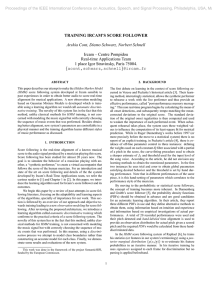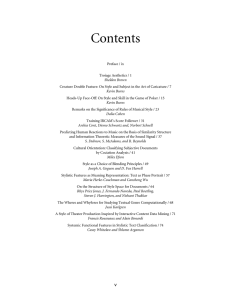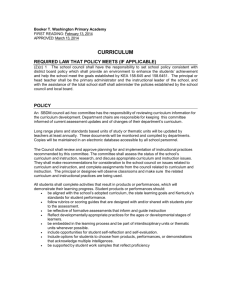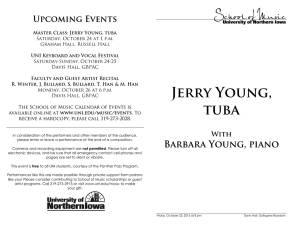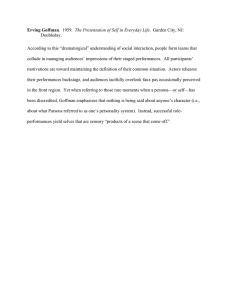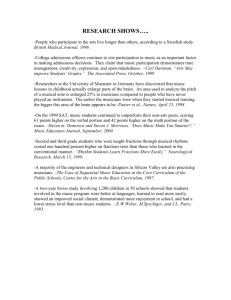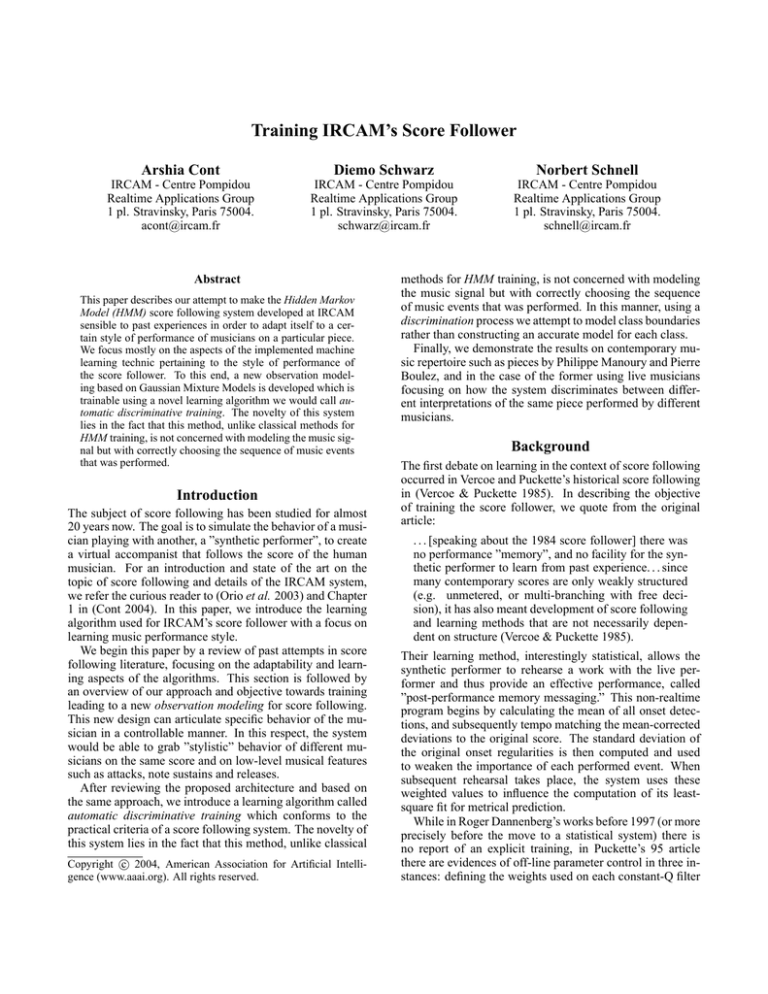
Training IRCAM’s Score Follower
Arshia Cont
Diemo Schwarz
Norbert Schnell
IRCAM - Centre Pompidou
Realtime Applications Group
1 pl. Stravinsky, Paris 75004.
acont@ircam.fr
IRCAM - Centre Pompidou
Realtime Applications Group
1 pl. Stravinsky, Paris 75004.
schwarz@ircam.fr
IRCAM - Centre Pompidou
Realtime Applications Group
1 pl. Stravinsky, Paris 75004.
schnell@ircam.fr
Abstract
This paper describes our attempt to make the Hidden Markov
Model (HMM) score following system developed at IRCAM
sensible to past experiences in order to adapt itself to a certain style of performance of musicians on a particular piece.
We focus mostly on the aspects of the implemented machine
learning technic pertaining to the style of performance of
the score follower. To this end, a new observation modeling based on Gaussian Mixture Models is developed which is
trainable using a novel learning algorithm we would call automatic discriminative training. The novelty of this system
lies in the fact that this method, unlike classical methods for
HMM training, is not concerned with modeling the music signal but with correctly choosing the sequence of music events
that was performed.
Introduction
The subject of score following has been studied for almost
20 years now. The goal is to simulate the behavior of a musician playing with another, a ”synthetic performer”, to create
a virtual accompanist that follows the score of the human
musician. For an introduction and state of the art on the
topic of score following and details of the IRCAM system,
we refer the curious reader to (Orio et al. 2003) and Chapter
1 in (Cont 2004). In this paper, we introduce the learning
algorithm used for IRCAM’s score follower with a focus on
learning music performance style.
We begin this paper by a review of past attempts in score
following literature, focusing on the adaptability and learning aspects of the algorithms. This section is followed by
an overview of our approach and objective towards training
leading to a new observation modeling for score following.
This new design can articulate specific behavior of the musician in a controllable manner. In this respect, the system
would be able to grab ”stylistic” behavior of different musicians on the same score and on low-level musical features
such as attacks, note sustains and releases.
After reviewing the proposed architecture and based on
the same approach, we introduce a learning algorithm called
automatic discriminative training which conforms to the
practical criteria of a score following system. The novelty of
this system lies in the fact that this method, unlike classical
c 2004, American Association for Artificial IntelliCopyright °
gence (www.aaai.org). All rights reserved.
methods for HMM training, is not concerned with modeling
the music signal but with correctly choosing the sequence
of music events that was performed. In this manner, using a
discrimination process we attempt to model class boundaries
rather than constructing an accurate model for each class.
Finally, we demonstrate the results on contemporary music repertoire such as pieces by Philippe Manoury and Pierre
Boulez, and in the case of the former using live musicians
focusing on how the system discriminates between different interpretations of the same piece performed by different
musicians.
Background
The first debate on learning in the context of score following
occurred in Vercoe and Puckette’s historical score following
in (Vercoe & Puckette 1985). In describing the objective
of training the score follower, we quote from the original
article:
. . . [speaking about the 1984 score follower] there was
no performance ”memory”, and no facility for the synthetic performer to learn from past experience. . . since
many contemporary scores are only weakly structured
(e.g. unmetered, or multi-branching with free decision), it has also meant development of score following
and learning methods that are not necessarily dependent on structure (Vercoe & Puckette 1985).
Their learning method, interestingly statistical, allows the
synthetic performer to rehearse a work with the live performer and thus provide an effective performance, called
”post-performance memory messaging.” This non-realtime
program begins by calculating the mean of all onset detections, and subsequently tempo matching the mean-corrected
deviations to the original score. The standard deviation of
the original onset regularities is then computed and used
to weaken the importance of each performed event. When
subsequent rehearsal takes place, the system uses these
weighted values to influence the computation of its leastsquare fit for metrical prediction.
While in Roger Dannenberg’s works before 1997 (or more
precisely before the move to a statistical system) there is
no report of an explicit training, in Puckette’s 95 article
there are evidences of off-line parameter control in three instances: defining the weights used on each constant-Q filter
associated with a partial of a pitch in the score, the curvefitting procedure used to obtain a sharper estimate of f0 and
threshold used for the input level of the sung voice. According to (Puckette 1995), he did not envision any learning
methods to obtain the mentioned parameters. In the first two
instances he uses trial and error to obtain global parameters
satisfying desired behavior and the threshold is set by hand
during performance. Note that in different performances of
the same piece, it is this hand-setting of parameters which
correlates to the performance style of the musician.
By moving to the probabilistic or statistical score followers, the concept of training becomes more inherent. In Dannenberg and Grubb’s score follower (Grubb & Dannenberg
1997), the probability density functions (PDFs) should be
obtained in advance and are good candidates for an automatic learning algorithm. In their article, they report three
different PDFs in use and they define three alternative methods to obtain them:
First, one can simply rely on intuition and experience
regarding vocal performances and estimate a density
function that seems reasonable. Alternatively, one can
conduct empirical investigations of actual vocal performances to obtain numerical estimates of these densities. Pursuing this, one might actually attempt to model
such data as continuous density functions whose parameters vary according to the conditioning variables
(Grubb & Dannenberg 1997).
Their approach for training the system is a compromise of
the three mentioned above. A total of 20 recorded performances were used and their pitch detected and hand-parsed
time alignment is used to provide an observation distribution
for actual pith given a scored pitch and the required PDFs
would be calculated from these hand-discriminated data.
In the HMM score following system of Raphael (1999),
he trains his statistics (or features in our system’s terminology) using a posterior marginal distribution {p(xk |y)}
to re-estimate his feature probabilities in an iterative manner (Raphael 1999). In his iterative training he uses signatures assigned to each frame for discrimination but no parsing is applied beforehand. In his latest system, incorporating Bayesian Belief Networks (BBN), since the BBN handles temporal aspect of the interpretation, several rehearsal
run-throughs are used to compute the means and variances
of each event in the score, specific to that interpretation
(Raphael 2001).
In the case of Pardo and University of Michigan’s score
follower, a training is done to obtain the probabilistic costs
which is independent of the score and performance and is
obtained by giving the system some musical patterns such
as arpeggios and chromatic scales (Pardo & Birmingham
2002). In this manner, the system should be incapable of
considering performance style issues.
Approach
Training in the context of score following is to adapt its parameters to a certain style of performance and a certain piece
of music. On the other hand, in the context of musical production at IRCAM and working with different musicians and
composers, implementation of a training system should ideally be unsupervised or at least automatic, without adding
anything to the tradition of music performance. In other
words, the system is created to realize the music as opposed
to selecting music to demonstrate the technology.
In this respect, we envision a system which learns or adapt
itself through a database of sound files of previous performances of the same piece or in the case of a creation, of
recorded rehearsals. After the offline and automatic learning, the system is adapted to a certain style of performance,
and thus provides better synchronization with the score in
real-time.
Figure 1 shows a general diagram of IRCAM’s current
score follower as a refinement of the model described in
(Orio & Déchelle 2001). In our approach to the described
problem, we have refined the observation modeling (the top
block in diagram) in order to obtain the desired architecture.
The decision and alignment block (lower block in diagram)
is described in details in (Orio & Déchelle 2001).
Audio frame data
Parameters
Score
Feature Calculation and Probability Observation
Feature probabilities
Hidden Markov Model
Score
...
...
Event Following
Figure 1: General diagram of IRCAM’s score following
Observation Modeling
Observation in the context of our system consists of calculating features from the audio spectrum in real-time and associate the desired probabilities for low-level states. Low-level
states used in our system are attack, sustain and release for
each note in the score; and spectrum features used are Log
of Energy, Spectral Balance and Peak Structure Match. We
will not get into the implementation details of the features
for two reasons:
• The proposed algorithm and design is independent of the
features and acts directly on the output of the features disregarding their implementation details.
• These details are covered in (Orio & Schwarz 2001; Cont
2004) and are not of the main interest of this paper.
It suffices to know that the Spectral Balance feature gives
a measure of balance between low-frequency and highfrequency contents of an analysis time-frame and the Peak
Structure Match (PSM) provides a measure of the spectral
pitch for every note in the score at each time-frame.
The observation process can be seen as a dimension reduction process where a frame of our data, or the FFT points,
lie in a high dimensional space, <J where J=2048. In this
way, we can consider the features as vector valued functions,
mapping the high dimensional space into a much lower dimensional space, or more precisely to 2 + N dimensions
where N is the number of different notes present in the score
for the PSM feature. Another way to look at the observation
process is to consider it as a probability mapping between
the feature values and low-level state probabilities.
In our model, we calculate the low-level state probabilities associated with each feature which in terms would be
multiplied to obtain a certain low-level state probability. As
an example, the Log of Energy feature will give three probabilities Log of Energy for Attack, Log of Energy for Sustain
and Log of Energy for Release. A diagram of the observation
process is demonstrated in Figure 2.
Audio Frame Data
Trained
Gaussian
Database
FFT
Log of Energy
LogE Rest
LogE Sustain LogE Attack
Rest State Probability
PSM
Spectral Balance
SB Rest
SB Sustain
SB Attack
Attack State Probability
PSM Sustain
PSM Attack
Sustain State Probability
Figure 2: Probability Observation Diagram
In order to calculate probabilities, each low-level state
feature probability (third layer in Figure 2) is using probability mapping functions from a database with stores trained
parameters. The probability mapping is derived from gaussians in forms of cumulative distribution function (CDF), inverse cumulative distribution function or a PDF depending
on the heuristics associated with each feature state. This architecture is inspired by Gaussian Mixture Models. Note
that the dimension of each model used is one at this time.
By this modeling we have assumed that low-level states’
attributes are not local which is not totally true and would
probably fail in extreme cases. However, due to a probabilistic approach, training the parameters over these cases
would solve the problem in most cases we have encountered.
Another assumption made is the conditional independence
among the features, responsible for the final multiplication
of the feature as in Figure 2.
Note that the observation process is in real-time and during the score alignment.
Training the Score Follower
Training is to adapt the observation parameters to a certain piece and certain style of performance. Speaking about
training for score following often initiates fear of system obsolesce and portability for musicians and composers using
the system. For this reason, we tend to specify what we
mean exactly by training.
In an ideal training, the system runs on a huge database of
aligned sound files and adapts its parameters to the performance. In this case, the training is usually supervised and
is integrated in the system’s practice. However, in a musical situation dealing with traditions of music rehearsals and
performances,
• Musicians prefer no additional item added to their practice situation.
• No database of aligned audio exists and moreover, working in the context of contemporary music limits the availability of different performances and recordings for a
piece.
• Whatever added to the system in general, should not reduce the portability of the piece. Musicians travel with
the piece!
The above constraints would limit the ideal training to an
unsupervised training, having few or just one rehearsal runthroughs to be observed. In this context, the training will
be off-line and would use the data during rehearsal to train
itself. Atleast for portability issues, training should be automatic.
Also from a developmental point of view, since score following is a work in progress as composers’ demands increase and change, training should be ideally independent
of features so that by introducing new features, training does
not need any change.
In this manner, with an ideal learning algorithm the system should be capable of modeling different styles of performances of a certain piece, giving more accurate models
for audio to score alignment.
The automatic discriminative training
In score following we are not concerned with estimating the
joint density of the music data, but are interested in the posterior probability of a musical sequence using the acoustic
data. More informally, we are not finally concerned with
modeling the music signal, but with correctly choosing the
sequence of music events that was performed. Translating
this concern to a local level, rather than constructing the set
of PDFs that best describe the data, we are interested in ensuring that the correct HMM state is the most probable (according to the model) for each frame.
This leads us to a discriminative training criterion. This
criterion has been described in (Renals et al. 1993) and in
the context of neural networks and not HMM models. Discriminative training attempts to model the class boundaries
— learn the distinction between classes — rather than construct as accurate a model as possible for each class. In practice this results in an algorithm that minimizes the likelihood
of incorrect, competing models and maximizes the likelihood of the correct model.
While most discriminative training methods are supervised, for portability issues and other reasons discussed before, we need our training to be automatic if not unsupervised. For this reason, we introduce an automatic supervision over training by constructing a discrimination knowledge by an alternative algorithm which forces each model
to its boundaries and discriminates feature observations. Yin
(de Cheveigne & Kawahara 2002) has been chosen as this
algorithm to provide discrimination knowledge.
Figure 3 shows a diagram of different steps of this training. The inputs of this training are an audio file plus its score.
There are two main cores to this system: Discrimination and
Training.
fa5
si5
re6
dod6
mi6
mib6
sib5
sold5
sol6
la5
fad6
fa6
sol5
do6
fad5
mib5
sold6
re5
mi5
dod5
la6
900
800
f0, Hz
700
600
Audio File
Score
500
Load Score
score parsing
Discrimination Knowledge
Yin
Feature Calculation
Discriminate Features
Low-level state features
400
300
215
Train Gaussians
EM Algorithm
220
225
230
235
240
frames
245
250
255
260
265
Figure 4: Discrimination using Yin
Construct Mappings
Training
Store
Mappings
Figure 3: Automatic Discriminative Training Diagram
Discrimination
By discrimination, we aim to distinguish low-level states in
the feature domain. In this process, as part of the training, a
set of states and their corresponding observations would be
obtained without actually segmenting or labeling the performance. The Yin algorithm (de Cheveigne & Kawahara 2002)
is used as the base knowledge. Note that Yin is originally a
fundamental frequency estimator and provides fairly good
measures of aperiodicity of each analysis frame. By a oneto-one correspondence between the observed data frames
and Yin’s analysis frames, and using Yin’s information for
each frame we decide on the type of the associated low-level
state (Attack, sustain and release) for each note in the score.
Figure 4 shows Yin’s f0 output together with score information as bands for each different note in the score
(Manoury’s ”En Echo” in this case), used to find event indices in analysis. The aperiodicity measure for each frame
discriminates between release and note events and if the detected note meets a minimum time length, about 20 frames
around the first index would be marked as the attack frame
indices as well as the rest for sustain frames. Using these
indices, we discriminate attack, release and sustain frames
from each feature’s observation. Obviously, each observation frame is assumed to have only one state type.
Figure 5 shows Log of Energy feature histograms on a
particular piece (”En Echo” by Philippe Manoury) along
with histogram for discriminated states in the same observation.
Having all features discriminated, we are ready to train
the gaussians. We evade using fitting algorithms due to
robustness and since we are dealing with gaussian mixtures (Reynolds 1995) and are planning more mixtures in
a row for future, we use EM Algorithm (Bilmes 1998;
Dempster, Laird, & Rubin 1977) to construct the gaussians
on observed discriminated features.
The result of the training is a set of PDFs that correspond
to each low-level state feature. We go further and construct
structures containing µ and σ values for each PDF as well as
the corresponding type of probability mapping for each state
feature and probability range and observed feature’s range
for calibration. This way each file structure would correspond to one state feature with all the above information.
This data will be stored in a database which will be used in
the real-time score follower’s observation block as shown in
Figure 2.
Response to performance style
Having the system trained and tested on different performances of the same piece with different musicians, the system tends to respond better in critical situations which are
mostly due to the style of performance and adaptability of
the new system. This becomes more clear when using one
performer’s parameters on another and on the same piece,
which would lead to imprecise alignment on critical phrases.
This is mainly due to the fact that there are eight different gaussians trained on different attributes of acoustic data
and mostly thanks to the discriminative training which emphasizes the distinction between each class rather than constructing an accurate model.
Figure 6 compares the gaussians obtained for Log of Energy on three different performances of ”En Echo” for voice
and computer of the composer Philippe Manoury, performed
by Michel-Dansac Donatienne, Valerie Philippin and Francoise Kubler in different sessions as an example.
Note that there are major differences for the release states
of the two performances. This is due to the fact that release
Histogram of Log of Energy in "En Echo"
7000
6000
Log of energy gaussians for Release
5000
Donatienne
Philippin
Kubler
statistics
4000
4
3000
3.5
3
2000
2.5
pdf
1000
2
0
0
1
2
3
feature value
4
5
6
1.5
Discriminated Sustain Histogram for Log of Energy
1200
1
0.5
1000
0
0.5
1
800
1.5
2
2.5
Feature values
statistics
Log of energy gaussians for note Sustain
0.35
600
Donatienne
Philippin
Kubler
0.3
400
0.25
200
0
1
2
3
feature value
4
5
6
pdf
0.2
0
0.15
Discriminated Release Histogram for Log of Energy
5000
0.1
4500
4000
0.05
3500
statistics
3000
0
−5
0
2500
5
10
Feature values
Log of energy gaussians for Attack
2000
0.35
Donatienne
Philippin
Kubler
1500
1000
0.3
500
0.25
0
0
0.5
1
1.5
2
feature value
2.5
3
3.5
4
0.2
Discriminated Attack Histogram for Log of Energy
pdf
50
45
0.15
40
0.1
35
statistics
30
0.05
25
0
−5
20
10
5
0
0
5
10
Feature values
15
0
0.5
1
1.5
2
2.5
feature value
3
3.5
4
4.5
5
Figure 5: Discrimination for LogE feature in ”En Echo”
with Donatienne as Soprano - From top to bottom: Log
of Energy histogram (non-discriminated) and discriminated
Sustain Log of Energy, Release Log of Energy and Attack
Log of Energy.
Figure 6: Trained gaussian examples for two separate performances of ”En Echo” of Manoury for soprano and electronics, performed by Michel-Dansac Donatienne, Valerie
Philippin and Francoise Kubler.
or silence correspond to background noise which is different for the two performances. For the Log of Energy feature,
it mainly acts as a threshold and during a live performance
it would be a matter of calibration of feature output to the
range observed during training. However, in the case of
Spectral Balance the difference is much bigger and is due
to the normalization used in the feature. In the latest system,
this normalization is cut off below a certain energy.
In the case of Attack and Sustain states, the most crucial parameters for the alignment, the difference between
the two performances is not huge to the human eye but even
the slight difference seen would lead to different system behavior during a live performance, especially for attacks and
critical phrases.
Conclusion
In this paper and in the context of a statistical HMM score
follower developed at IRCAM, we present a new approach
for the observation modeling which can articulate specific
behavior of the musician in a controllable manner. In this respect, the system would be able to grab ”stylistic” behaviors
of different musicians on the same score and on low-level
musical features such as attacks, note sustains and releases.
Using this approach, a novel learning algorithm called
automatic discriminative training was implemented which
conforms to the practical criteria of a score following system. The novelty of this system lies in the fact that this
method, unlike classical methods for HMM training, is not
concerned with modeling the music signal but with correctly
choosing the sequence of music events that was performed.
The new system has been tested on contemporary music
repertoire such as pieces by Philippe Manoury and Pierre
Boulez, and in the case of the former using live musicians.
During the tests it has proved to be adaptable to certain style
of performance in the case of different musicians performing
the same piece and thus, providing a better score following
for phrases undergoing changes for different performance
styles.
Being rather simple, the system tends to model the margins of different styles of performance to a good extent and
moreover, might be a point of departure for further studies
in the context of score following and style analysis.
Acknowledgements
We are grateful to Philippe Manoury, Serge Lemouton and
Andrew Gerszo without whose valuable comments and presence during test sessions the project could not have advanced. We would also like to thank the anonymous reviewers for their valuable comments on the draft of this paper.
We would like to acknowledge Nicolq Orio’s ground laying
work as the founder of this research project.
References
Bilmes, J. 1998. A Gentle Tutorial of the EM Algorithm
and its Application to Parameter Estimation for Gaussian
Mixture and Hidden Markov Models. ICSI.
Cont, A. 2004. Improvement of observation modeling for
score following. Master’s thesis, University of Paris 6, IRCAM, Paris.
de Cheveigne, A., and Kawahara, H. 2002. YIN, a fundamental frequency estimator for speech and music. J.
Acoust. Soc. Am. 111:1917–1930.
Dempster, A.; Laird, N. M.; and Rubin, D. B. 1977. maximum likelihood from incomplete data via the EM algorithm. Journal of Royal Statistical Society 39(B):1–38.
Grubb, L., and Dannenberg, R. B. 1997. A Stochastic
Method of Tracking a Vocal Performer. In Proceedings of
the ICMC, 301–308.
Orio, N., and Déchelle, F. 2001. Score Following Using
Spectral Analysis and Hidden Markov Models. In Proceedings of the ICMC.
Orio, N., and Schwarz, D. 2001. Alignment of Monophonic and Polypophonic Music to a Score. In Proceedings
of the ICMC.
Orio, N.; Lemouton, S.; Schwarz, D.; and Schnell, N.
2003. Score Following: State of the Art and New Developments. In Proceedings of the International Conference on
New Interfaces for Musical Expression (NIME).
Pardo, B., and Birmingham, W. 2002. Improved Score
Following for Acoustic Performances. In Proceedings of
the ICMC.
Puckette, M. 1995. Score Following Using the Sung Voice.
In Proceedings of the ICMC, 199–200.
Raphael, C. 1999. Automatic Segmentation of Acoustic Musical Signals Using Hidden Markov Models. IEEE
Transactions on Pattern Analysis and Machine Intelligence
21(4):360–370.
Raphael, C. 2001. A Bayesian Network for Real Time Music Accompaniment. Neural Information Processing Systems (NIPS) (14).
Renals, S.; Morgan, N.; Bourlard, H.; Cohen, M.; and
Franco, H. 1993. Connectionist probability estimators in
HMM speech recognition. IEEE Transactions Speech and
Audio Processing.
Reynolds, D. A. 1995. Speaker identification and verification using gaussian mixture speaker models. In Speech
Communication, volume 17, 91–108.
Vercoe, B., and Puckette, M. 1985. Synthetic Rehearsal:
Training the Synthetic Performer. In Proceedings of the
ICMC, 275–278.

